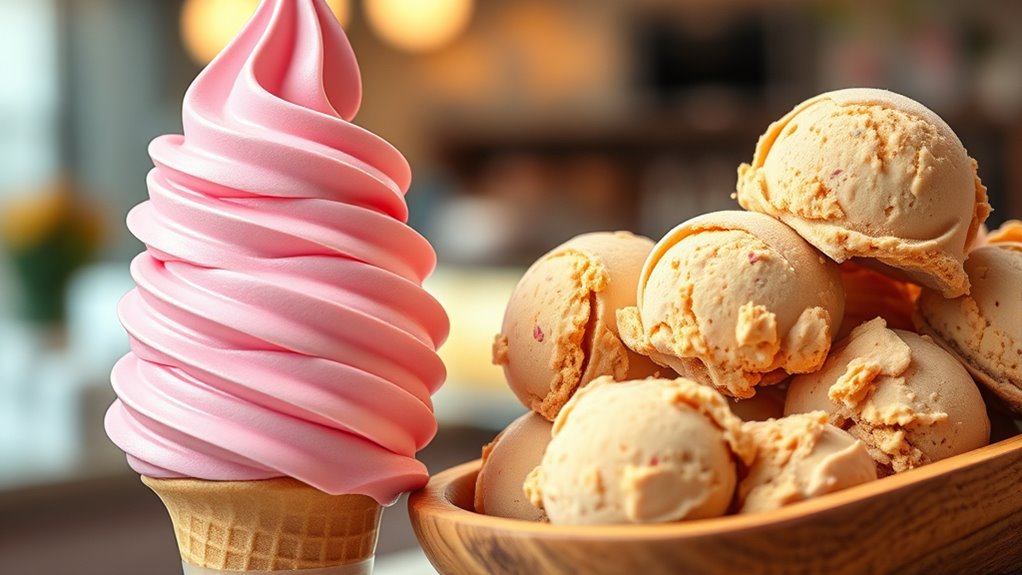Soft serve typically outsells hard ice cream because it’s quicker to serve, more versatile with flavors, and attracts a broader customer base with regular innovation. Its convenience makes it popular in fast-paced environments like amusement parks and malls, while its ability to offer trendy and seasonal options appeals to younger crowds. If you want to understand why soft serve leads and what makes it so appealing, there’s more behind the trend you’ll find interesting.
Key Takeaways
- Soft serve generally outsells hard ice cream due to its quick serving, trend-driven flavors, and adaptability to fast-paced environments.
- Soft serve’s frequent flavor innovations and seasonal options attract a broader, often younger, customer base.
- Hard ice cream appeals to consumers seeking a richer, traditional dessert, often during special occasions or for longer-lasting treats.
- The convenience and quick service of soft serve make it more popular in high-traffic locations like amusement parks and malls.
- Overall sales trends favor soft serve in many markets, driven by its flexibility, trendy appeal, and ability to meet diverse customer preferences.

When it comes to ice cream, many people wonder how soft serve stacks up against traditional hard ice cream. Both have their loyal fans, but understanding what drives their popularity can help you see why one might outsell the other. Soft serve is known for its smooth, creamy texture and quick-serving convenience, which appeals to those seeking a fast, satisfying treat. Hard ice cream, on the other hand, offers a dense, rich flavor experience that many people associate with quality and tradition. The key difference often comes down to flavor innovation and customer preferences. Soft serve vendors tend to experiment more with flavors, offering seasonal or limited-edition options that keep the product fresh and exciting. These constant updates attract customers looking for novelty, making soft serve a dynamic choice that aligns with current trends and tastes. You might notice shops introducing unique mix-ins, swirls, or even healthier options, catering to a wide range of preferences. This flexibility in flavor innovation keeps soft serve appealing, especially to younger audiences who crave variety and new experiences. Additionally, soft serve’s ability to be easily customized allows vendors to cater to specific dietary needs and preferences, further boosting its popularity.
Customer preferences play a significant role in determining which type of ice cream sells more. Many consumers prioritize convenience and immediate gratification, which soft serve readily provides. Its quick serve-ability makes it ideal for busy locations like amusement parks, malls, or street vendors, where people want a treat on the go. Conversely, hard ice cream often attracts those who value a more substantial, long-lasting dessert. When you think about it, hard ice cream’s classic appeal, especially with its traditional scoops and wide array of flavors, aligns with consumers who appreciate quality and nostalgia. People often seek out hard ice cream for special occasions or when they want a more indulgent experience, which can boost its sales in certain contexts. However, soft serve’s ability to adapt to customer preferences by offering customizable options, such as mix-ins or different flavors, gives it a competitive edge in places where variety and speed matter most.
Ultimately, the sales battle between soft serve and hard ice cream depends on where you are and what customers want. Soft serve’s flavor innovation and versatility appeal to those craving novelty and quick service, helping it gain popularity in fast-paced environments. Meanwhile, hard ice cream’s traditional, indulgent qualities attract customers seeking a richer, more substantial treat. Both have their strengths, but if you’re looking at overall sales, soft serve’s adaptive, trend-friendly approach makes it more likely to outsell hard ice cream in many settings today. Recognizing the importance of favorable customer experience can be a key factor in understanding these sales dynamics.
Frequently Asked Questions
Which Type Has a Longer Shelf Life?
You might wonder which type of ice cream has a longer shelf life, considering ice cream spoilage and storage requirements. Generally, hard ice cream lasts longer because it’s stored at consistent freezing temperatures, reducing spoilage risks. Soft serve, with its higher air content and softer texture, requires immediate consumption or specialized storage. Properly stored hard ice cream stays good longer, making it more practical for extended shelf life and less prone to spoilage.
Are There Health Differences Between Soft Serve and Hard Ice Cream?
Imagine you’re choosing between soft serve and hard ice cream. While both contain dairy, soft serve often has slightly higher dairy fat content, which can impact calorie intake. However, some soft serve varieties include probiotic benefits, aiding digestion. Overall, health differences depend on ingredients and portion sizes. You should read labels to make informed choices, especially if you’re concerned about dairy fat or seeking probiotic benefits.
How Do Ingredient Costs Compare for Each Type?
When comparing ingredient costs, you’ll find soft serve generally has lower ingredient pricing because it uses a more streamlined mix and less cream, reducing production expenses. Hard ice cream often involves higher-quality ingredients and more extensive processing, which raises costs. Your choice depends on balancing ingredient pricing and production expenses, but soft serve typically offers a more cost-effective option for quick, inexpensive servings.
Which Appeals More to Children?
You notice that kids’ flavor preferences often lean towards sweeter, more colorful options, making soft serve more appealing to children. Its vibrant presentation and smooth texture attract young customers, who are drawn to fun, eye-catching treats. Soft serve’s playful appeal and customizable toppings make it a favorite among kids, increasing its popularity in areas catering to families. So, soft serve generally resonates more with children’s tastes and visual appeal.
Do Regional Preferences Influence Sales?
Regional preferences definitely influence sales, as seasonal trends and cultural influences shape people’s choices. You’ll notice that in warmer areas, soft serve tends to sell more due to its invigorating nature. Conversely, in regions with strong traditional or cultural ties to certain flavors, hard ice cream may dominate. These factors lead to variations in sales, making it essential for ice cream brands to adapt their offerings based on local tastes and seasonal shifts.
Conclusion
Ultimately, whether you choose soft serve or hard ice cream, you’re embracing more than just a treat—you’re savoring a moment of joy. Soft serve, with its swift, fleeting swirl, symbolizes spontaneity and carefree fun, while hard ice cream, with its solid, lasting presence, stands for tradition and stability. Both remind you that life’s sweetest moments come in different textures, but it’s your choice to enjoy them fully. After all, happiness is what you make of it.










